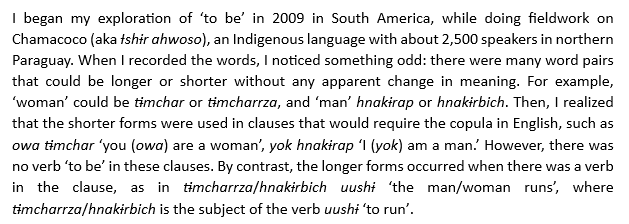Celebrating 25 Years of Regional NRM
The 9th National Natural Resource Management Knowledge Conference, held September 8–12 in Cairns, marked a significant milestone, 25 years since Australia adopted the regional natural&...

Dr Luca Ciucci commenced this linguistic project in 2020 at The Cairns institute. He carried out fieldwork on Zamucoan and worked on the book on non-verbal predication. He informs us that the books are now complete and this is his story to tell.
“To be or not to be?”
Non-verbal predication across the world’s languages
The verb ‘to be’ in English is a special word. It looks like a verb, but when it is used in a clause, its properties differ from those of a typical verb. Indeed, it can be a copula, as in that is the question, or an auxiliary (I am writing). But why is to be different?
And how is it expressed in the world’s languages?

Chamacoco belongs to a small language family called Zamucoan. There are only two other documented Zamucoan languages:
Ayoreo (5,000 speakers in northern Paraguay and southeastern Bolivia) and Old Zamuco (spoken in the 18th century). My comparison revealed that they show a contrast between longer and shorter noun forms similar to that of Chamacoco. This is the core of the Zamucoan nominal system, which is even more complex and unique, as describe in my book on Zamucoan languages (Ciucci 2016). Later, a comparative study I co-authored (Bertinetto et al. 2019) showed that having a shorter noun form that serves a function equivalent to that of the noun plus the copula is something rare in the world’s languages, while the absence or omission of the copula itself is well known crosslinguistically. For instance, in Hungarian, ‘János is a teacher’, János tanár, is literally ‘János teacher’.
These findings were for me the initial step towards a more systematic study on how the world’s languages express the functions covered by English copula ‘to be’. We talk about “non-verbal predication” because ‘to be’ is, from a technical perspective, not a proper verb but rather a verb-like element.
Indeed, in many languages, such as Chamacoco and Hungarian, a copula is not (or not always) used. Although “non-verbal predication” may sound like an opaque label for laypeople, we all use non-verbal predication many times every single day.
In 2020, Pier Marco Bertinetto (Scuola Normale Superiore, Pisa, Italy), Denis Creissels (Université Lumière Lyon 2, France) and I started a project on non-verbal predication that lasted five years and involved the collaboration of 40 scholars from around the world.
The outcome of this project is a multivolume work that has just appeared, Non-verbal predication in the world’s Languages: A typological survey (Bertinetto et al. 2026a,b). The book consists of two volumes with a total of about 1,300 pages plus supplementary materials (https://www.degruyterbrill.com/serial/chl-9-b/html).
It has appeared in the series Comparative Handbooks of Linguistics, by De Gruyter Mouton, and we hope that it will serve as a useful reference on non-verbal predication for years to come. Its 33 chapters, written by leading specialists, present a new typological framework for the study of non-verbal predication and provide detailed descriptions from selected languages and families across Eurasia, the Americas, Africa, and Oceania.
In this work particular attention is given to languages from traditionally little-described families, such as the small Zamucoan family, which first sparked my interest for the fascinating topic of non-verbal predication.
References
November 2025


The 9th National Natural Resource Management Knowledge Conference, held September 8–12 in Cairns, marked a significant milestone, 25 years since Australia adopted the regional natural&...
The Tropical North Queensland Drought Resilience Hub's Sustainable Aboriginal and Torres Strait Islander Enterprise Program (SATSIE), in collaboration with the North Australian Indigeno...
A special visit for students from AFL Cape York House for Girls (AFLCYHG) to the Local Indigenous Food Enterprise Services (LIFES) garden was facilitated through The Tropical North Quee...
James Cook University (JCU) 2025 cohort of Master of Global Development (MGD) students visited Mossman recently to observe and engage with a community in transition from sugar to a mode...
Four members of the Far North Queensland (FNQ) Connect team embarked on an eventful journey around Cairns city - but this was no ordinary outing. The colleagues were taking part in Spi...
During a recent visit to Waibene (Thursday Island), Jen McHugh toured the community centre Buai Mudh, meaning Family House, and met with board members of the Mura Kosker Sorority who op...
James Cook University (JCU) researchers from Cairns and Townsville joined an in-person forum at the JCU's Bada-Jali campus on September 23 and 24 for a university-wide plan to progress ...
The Whitsundays provided a valuable platform for producers, industry and community to share knowledge, compare practice, and explore new approaches that support resilience to a more var...
© 2025 The Cairns Institute | Site Map | Site by OracleStudio | Design by LeoSchoepflin